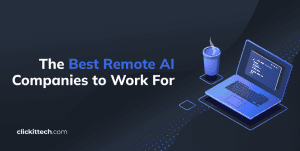When understanding AI vs Machine Learning, it’s essential to grasp how these innovations shape the future of business, healthcare, finance, and more. These technologies are fuelling daily luxuries and completely changing entire businesses.
According to a recent survey by Access Partnership on behalf of Amazon Web Services (AWS), employers and employees in the United States anticipate a 44% gain in worker efficiency due to full AI utilization in the healthcare industry. However, there are many obstacles to achieving this boost. 38% of employees are expected to utilize AI-powered tools by 2028, yet 78% of companies find it difficult to adopt AI training because they don’t know enough about it.
This blog will walk you through the basics of AI vs Machine Learning, highlight their salient distinctions, and delve into their various applications in various industries as we traverse the rapidly changing field of AI and ML.
- What’s the Difference Between AI and Machine Learning?
- AI vs Machine Learning Comparison
- How Industries Use AI and Machine Learning
- Conclusion
What’s the Difference Between AI and Machine Learning?
AI uses a variety of methods and tools to try to mimic human intellect and manage complicated jobs. On the other hand, machine learning (ML) is centered on using statistical techniques and algorithms to learn from data to enhance performance. These differences in objectives, methods, implementations, and requirements illustrate how AI vs ML complement each other.
What is Artificial intelligence?
Artificial Intelligence refers to the ability of machines, especially computer systems, to simulate human intelligence. AI systems are designed to perform tasks like recognizing patterns, solving problems, making decisions, and understanding language – tasks that typically require human intelligence.
The fundamental goal of Artificial Intelligence is to make machines capable of simulating human cognitive processes and continuously enhancing their performance via experience.
E.g.Virtual assistants, such as AWS Alexa, Google Assistant, or Siri, that hear spoken commands and perform tasks are examples of how AI technology may have real conversations with people. With technologies like DALL·E or ChatGPT, AI may also generate new images and texts based on user requests. Additionally, AI systems can make real-time decisions by analyzing data, such as in self-driving cars.
- Amazon Q:
A generative AI assistant tailored for work, customizable to meet your business needs. - Amazon Bedrock:
Effortlessly build and scale applications using large language models (LLMs), foundation models (FMs), and generative AI tools. - Amazon Transcribe:
Quickly and accurately convert speech to text with a robust API for real-time and recorded audio and video. - Amazon Polly:
Convert text into lifelike speech, enabling you to create talking applications and develop new speech-enabled products. - Amazon Textract:
Automatically extract text, handwriting, and data from scanned documents with precision. - Amazon Rekognition:
Utilize customizable and pre-trained computer vision capabilities to derive information and insights from your images and videos. - Amazon Lex:
Create, build, test, and deploy conversational interfaces in applications using advanced natural language models. - Amazon Translate: A neural machine translation service that offers fast, high-quality, cost-effective, and customizable language translation.

Read our blog The best artificial Intelligence Tools for Development
What is Machine Learning?
Machine Learning is a subset of Artificial Intelligence that enables machines to learn from data and improve their performance without requiring explicit programming for each task.
ML algorithms use large amounts of data to identify patterns, make predictions, or solve problems instead of following specific instructions. Machine learning models improve in accuracy and efficiency over time as more data is handled. This makes it possible for them to manage difficult jobs like speech translation, picture identification, and even customer preference prediction across a range of businesses.
E.g.
Machine learning services are used by recommendation systems on streaming services like Netflix and YouTube to make content recommendations based on your viewing interests and history.
Check out our blog about Netflix architecture to give you an overview of how ML can help your application.
- Amazon SageMaker:
Build, train, and deploy ML models at scale. - AWS Deep Learning AMIs:
Quickly build scalable, secure deep learning applications in pre-configured environments. - AWS Deep Learning Containers:
Quickly deploy deep learning environments with optimized, prepackaged container images. - TensorFlow on AWS:
Enhance and visualize deep learning applications with ML tools. - PyTorch on AWS:
Leverage a highly performant, scalable, and enterprise-ready PyTorch experience on AWS. - Apache MXNet on AWS:
Build ML applications that train quickly and run virtually anywhere. - Jupyter on AWS:
A secure, scalable, and collaborative Jupyter experience on AWS.
Have a look of our video about the Top 5 AWS Machine learning Services:
AI vs Machine Learning Comparison
The phrases Artificial intelligence and Machine learning are frequently used synonymously in the context of emerging technologies, although they have distinct meanings. Understanding the differences between AI vs Machine Learning is crucial to grasping how these technologies influence various sectors. While both aim to make machines smarter, they do so in different ways.
So, let’s break down the differences across four key areas: Objectives, Methods, Implementations, and Requirements.
| Category | Artificial Intelligence (AI) | Machine Learning (ML) |
| Objective | Simulates human intelligence for complex tasks | Learns from data to improve performance |
| Methods | Uses neural networks, rule-based systems, evolutionary algorithms | Employs statistical methods, deep learning, supervised/unsupervised learning |
| Implementation | Resource-intensive, often through prebuilt solutions (APIs) | Focuses on training models with data and refining over time |
| Requirements | Requires massive datasets, computing power, complex algorithms | Needs large, high-quality data and computational resources |

AI vs Machine Learning: Objectives
- Artificial Intelligence
The main goal of AI is to simulate human intellect in machines. AI systems are designed to perform difficult tasks typically performed by humans, like problem-solving, decision-making, natural language processing, and visual perception. Artificial Intelligence aims to equip machines with the ability to reason and behave independently in various scenarios. - Machine Learning
Machine learning, or ML, aims to allow machines to learn from data without the need for human interaction. Machine learning systems find patterns in data and gradually enhance their functionality. Instead of explicitly designing each task’s algorithm, the emphasis is on creating algorithms that can automatically learn from experience and get better at it.
AI vs Machine Learning: Methods
- Artificial Intelligence
AI employs various techniques to produce intelligence, such as neural networks, expert systems, rule-based systems, search algorithms, and evolutionary algorithms. Artificial intelligence (AI) systems can be built using deep learning frameworks that imitate the neural architecture of the human brain or with specialized logic-based rules. - Machine Learning
Machine learning uses statistical methods and data-driven algorithms to process and learn from data. To evaluate massive datasets, ML models employ techniques like deep learning, reinforcement learning, unsupervised learning, and supervised learning. These techniques allow the system to produce outputs, classify data, and make predictions without following predetermined guidelines.
AI vs Machine Learning: Implementations
- Artificial Intelligence
Artificial intelligence implementations are frequently more resource-intensive and complex. A lot of firms choose to adopt prebuilt AI solutions rather than creating AI from the ground up. These well-researched solutions are available through Application Programming Interfaces (APIs), facilitating easy integration with current products and services. - Machine Learning
The two main steps in the machine learning implementation process are selecting and preparing a training dataset and deciding on an appropriate machine learning model—such as decision trees or linear regression. Data scientists train the model with relevant data and then continuously refine it using updated data and error-checking techniques. The more diverse and high-quality the data, the more accurate the machine learning model is.
AI vs Machine Learning: Requirements
- Artificial Intelligence
To develop AI systems, a wider range of resources is required. These include massive datasets, powerful computers, complex algorithms, and sometimes even human rule and constraint definition expertise. To replicate human-like intelligence across domains, Artificial Intelligence (AI) also needs to be integrated with a range of other technologies, such as Natural Language Processing (NLP), Computer Vision, and Robotics. - Machine Learning
Large quantities of high-quality data are needed explicitly for machine learning to train its models. Robust computational resources are also required by ML systems for processing and training models. The availability of precise, labeled data, which aids the model in learning patterns and producing precise predictions, is crucial to machine learning efficacy. A feedback loop that allows the system to assess its performance and adjust to fresh data is essential to machine learning.
Moving further, we will look into the various industries where these technologies are employed, showcasing their practical impact and integration.

How Industries Use AI and Machine Learning
Artificial Intelligence and Machine Learning are transforming various industries by enhancing efficiency, improving decision-making, and driving innovation. These technologies are having a major impact on several areas, as follows:
Healthcare
AI vs ML are transforming medical research and patient care in the healthcare industry. AI-powered devices help in disease diagnosis by accurately analyzing medical images, including MRIs and X-rays. Using past data, machine learning algorithms assist in tailoring treatment methods and forecasting patient outcomes. Furthermore, AI-powered chatbots and virtual assistants save tasks like appointment scheduling and patient record management, giving healthcare workers more time.
Read our blog Data Analytics in Healthcare to learn more!
Retail
AI and ML improve consumer experiences and operational efficiency for the retail sector. To provide specific recommendations and focused marketing, Artificial Intelligence (AI) algorithms analyze consumer behavior and interests. Machine learning models enhance inventory control by forecasting demand trends and streamlining replenishment procedures. Furthermore, AI-driven chatbots offer round-the-clock customer service, answering questions and resolving problems.
Finance
AI and ML are essential to risk management, fraud detection, and customer service in the banking industry. To identify anomalies and stop fraud, Machine Learning systems examine transaction trends. Financial organizations can make better investment decisions and risk management with the use of AI-driven analytics solutions. AI also improves client service by means of chatbots that help with account management and financial planning, as well as automated financial advisors.
Manufacturing
Manufacturing is changing as a result of AI and ML improvements in product quality and production efficiency. Algorithms for predictive maintenance examine machine data to anticipate possible problems before they arise, cutting downtime and repair expenses.
AI-driven quality control systems use computer vision to check items for flaws, guaranteeing high standards and reducing waste. Machine learning algorithms enhance supply chain management by predicting demand and simplifying logistics.
Cybersecurity
AI and ML are essential for real-time threat detection and response in cybersecurity. Artificial Intelligence (AI) algorithms examine user behavior and network traffic to spot possible breaches and suspicious activity. By continuously enhancing their detection capabilities and learning from previous attacks, Machine Learning models adjust to changing threats. By taking a proactive stance, companies can improve their security posture and protect sensitive data.
SaaS
AI and ML boost user experience and expand product options for SaaS companies. Businesses can optimize their software solutions by using AI-driven analytics tools, which offer insights into user behavior and application performance. Machine learning algorithms personalize user experiences through feature and content recommendations based on user preferences. AI also improves service efficiency and satisfaction by automating customer care through chatbots and virtual assistants.
| Industry | AI | ML |
| Healthcare | Analyzes medical images, assists in diagnosis, automates administrative tasks | Predicts patient outcomes, tailors treatment plans using historical data |
| Retail | Analyzes consumer behavior, provides personalized recommendations | Forecasts demand trends, optimizes inventory management |
| Finance | Uses computer vision for quality control, reduces downtime with predictive maintenance. | Detects transaction anomalies, improves risk management |
| Manufacturing | Uses computer vision for quality control, reduces downtime with predictive maintenance | Optimizes supply chains, predicts logistics demands |
| Cybersecurity | Detects security threats through behavior analysis | Learns from previous attacks to adapt to new threats |
| SaaS | Provides insights into user behavior, automates customer service | Personalizes user experience, offers feature recommendations |
Conclusion
In this blog, we explored AI vs Machine Learning, breaking down the differences in objectives, methods, implementations, and requirements. These technologies have moved beyond being just buzzwords to becoming real, impactful tools that are transforming industries worldwide. From improving healthcare and retail experiences to managing financial risks, optimizing manufacturing, boosting cybersecurity, and advancing SaaS platforms, AI and Machine Learning is driving innovation and creating new opportunities for efficiency.
By harnessing the unique strengths of AI to simulate human intelligence and ML’s capacity to learn from data, businesses are enhancing their operations and discovering new ways to tackle complex challenges. As AI vs Machine Learning continues to evolve, their integration across industries will only grow, shaping the future of work and innovation.
FAQs
AI is when machines are made to act like humans and make decisions, while ML is a part of AI that helps machines learn from data without needing specific instructions for each task.
We use AI and Machine Learning in things like voice assistants (Siri, Alexa), recommendations on Netflix or YouTube, facial recognition, self-driving cars, online shopping, and spotting fraud in banking.
While AI and ML can automate repetitive tasks, they also generate new employment opportunities in Data Science, AI Development, and System Management. Improving human potential is the aim, not necessarily replacing jobs.









